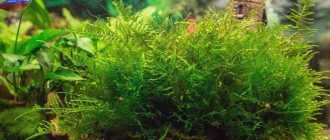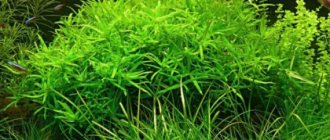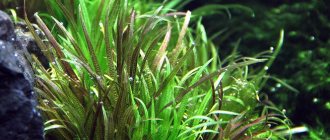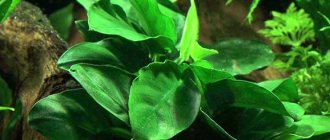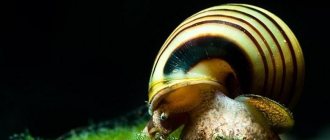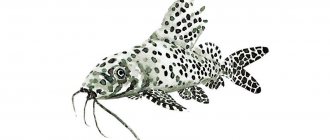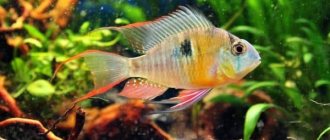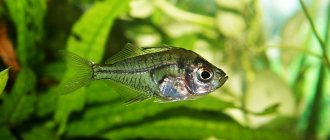At the same time, the microanthemum can reach up to 10 cm in length, in contrast to the hemianthus cube, with which they have many similar features, including appearance.
The width of the Micrantemum Monte Carlo bush reaches an average of 5-7 mm. The shoots either spread along the ground or are located vertically. Another distinctive feature of the plant is its relatively large, rounded leaves. The length of the leaf plate is usually 2-5 mm and the width is 1.5-2 mm. The leaves are collected on the stem in whorls of 2-4 pieces. The roots look like thin white threads.
Micranthemum Monte Carlo has smaller leaves at the base of the branches. The size of the leaf blade gradually increases towards the end of the stem.
Fans of aquascaping are attracted to micronetmum by one of its unusual properties. Small air bubbles often form on its leaves, which give beautiful reflections in the light. This gave birth to a new common name for the plant - “pearl grass”.
Appearance
Hemianthus micranthemoides or few-flowered is an aquatic plant with long, slightly branching shoots. The flower produces many thin stems that can either grow upward or creep along the bottom. Each branch is covered with small leaves, collected in whorls of 2-3-4 pieces. The leaves have the shape of an elongated oval, barely reach 4–5 mm in length, and the width is only 1.5–2 mm. They have no petioles. The entire plant is painted in a rich, bright green color. Hemianthus received the nickname “Pearl Grass” for its ability to form air bubbles on the leaves, which shimmer beautifully in the light.
What to make a greenhouse from
Plastic and glass containers are most suitable for arranging a greenhouse.
Plastic food containers are well suited for making greenhouses for aquarium plants.
It can be:
- containers with lids;
- pastry or cake packaging;
- disposable glasses;
- cut bottles;
- coffee cans;
- empty aquarium, etc.
Editorial: Ornatus
Keeping plants out of water is easy. A little skill in growing garden and indoor flowers will be enough.
The roots need good drainage, otherwise they will rot and the sprouts will die. To do this, fill the bottom of the selected container with fine gravel (fraction up to 5 mm), expanded clay, perlite, Kapchagai aquarium soil, etc. You can perforate the bottom and place the container on a pallet.
The soil should be light, moisture-absorbing, non-alkaline (pH less than 7). A universal garden mixture, leaf soil with peat or the addition of vermicompost will do. A layer of coarse sand is poured on top.
Fine gravel and specialized soil are used as a substrate for the greenhouse.
The total thickness of the substrate is 3-6 cm.
Example:
- gravel substrate – 1-2 cm;
- soil – 3-3.5 cm;
- sand – 0.5 cm.
The seeds are poured on top of the moistened substrate. Sometimes cuttings are rooted in the same way, but more often they are dug in. Air humidity should be high. To do this, cover the top of the container with glass, a transparent lid or cling film and ventilate it periodically, for example during watering. A small greenhouse can be placed under a cap made from a cut-off plastic bottle.
After planting the seeds, the greenhouse is placed on a windowsill or in a well-lit place.
The containers are placed on the windowsill. In the autumn-winter period, and sometimes all year round, additional lighting is required. It is selected individually.
It is necessary to take into account the moisture-loving nature of these plant forms. It is necessary to keep the soil constantly moist; drying out of the earthen coma is unacceptable. It is regularly moistened with a spray bottle, avoiding waterlogging.
Also, seedlings should not be exposed to dry air flow, cold drafts, or temperature changes. A standard complex of liquid mineral fertilizers is used as fertilizing.
When they get stronger, the lid can be removed for a while, gradually accustoming them to living conditions. Not all aquacultures can adapt, so you need to carefully monitor their reaction, increasing humidity to the same level if necessary. Staurogynes, glossostigmas, eleocharis, pogostemons, utricularia, lileopsis, etc. get used to room conditions better than others.
It is allowed to grow aquarium seedlings in a flower pot. In this case, it can be placed inside a transparent plastic bag. To maintain high air humidity, the edges of the bag are tied or secured with an elastic band. Several flowerpots can be installed in an empty aquarium and covered with a glass panel on top.
You can change the terrestrial environment to an aquatic one when the young plants are fully grown.
The purpose of planting in an aquarium.
Micranthemum sp. Monte Carlo is used for planting in the foreground of an aquarium - to create a mat and/or a smooth transition from the foreground to the middle and to transition from plants with small leaves to medium ones.
Micranthemum "Monte Carlo" is a ground cover plant and is visually similar at first glance to Hemianthus cube . Although, if you look more closely, it is very different in that it has larger (up to 3 mm) leaves and a root system that simply grows into the ground, forming a carpet of leaves.
Description of the plant
Micranthemum Monte Carlo is a long-stemmed plant that, thanks to its creeping rhizome and creeping stem, covers the ground with a dense carpet. Here are the main characteristics of microrantemum:
- stem branching, creeping, about 0.6 mm thick;
- leaves are round, oppositely located, 1 cm in diameter, sitting on short petioles;
- the root is long, creeping, with additional thread-like roots of white color, well fixed in the soil.
Return to content
Requirements for growing Micrantemum "Monte Carlo".
Micranthemum sp. Monte Carlo is not a very picky plant to grow.
Its main requirements, like any ground cover plants, are intense light, a soil nutrient substrate, water enriched with CO2, and a temperature of 23-28°C. As for water hardness, the requirements are minimal - from very soft to very hard (dh=4-20°). Acidity should be average from 5 to 7.5.
By purchasing this plant and planting it in your aquarium, you will enjoy every day admiring its beauty and watching the growth and appearance of a mat in the foreground of the aquarium.
Comfortable conditions
For the normal development of the Monte Carlo microrantemum, the following conditions are necessary:
- soil - ordinary sand or fine gravel with a fraction of 1-3 mm;
- temperature from 23°C to 28°C;
- water hardness from 4dH to 20dH;
- pH from 5 to 7.5 units;
- CO2 content from 5 to 10 mg/l;
- weekly change of 25-30% water;
- intensive filtration;
- slight current;
- fertilizing with mineral fertilizers and iron.
Return to content
Content
Water parameters. The aquarium plant tolerates conditions in hard water up to 16 dGH, and in soft water no more than 2 dGH. The temperature limit can vary from 15 to 29°. ATTENTION! PH should be between 6.5–8 units! A decrease greater than 6 leads to the development of various problems. Aquarium dimensions. Both dimensions and shape have no meaning for hemianthus. Priming. Pearl grass has short, underdeveloped roots, so sand of medium and fine fractions is most suitable for it. Feeding. Hemianthus micranthemoides loves mineral fertilizers. In addition, clay lumps are a good feed for it. Regular application of these fertilizers to the soil will accelerate the growth of shoots and improve the color of the green mass. Lighting.
The main factor in the full development of the plant. An aquatic resident can grow well and form lush bushes only in bright light. A lack of lighting will cause the shoots to stretch and stretch upward, and the delicate green color will change to an unpleasant brown one. The minimum lighting limit is 0.5–0.6 V per liter of water. The duration of daylight hours should not exceed 12 hours. Otherwise, there is a high probability of rapid growth of green and blue algae parasitizing the hemianthus. Aeration. For plant growth, a constant supply of carbon monoxide, also known as carbon dioxide, is required. Filtration. Clean water is a necessary condition for the normal maintenance of hemianthus. In a polluted environment, the growth of parasitic algae increases.
Therefore, the aquarium must be equipped with a good filter and some of the water must be replaced with fresh water every week. Trimming. When decorating an aquarium in a strict style, for example, Dutch, the plant will have to be constantly trimmed to maintain the neat shape of the bush. Hemianthus tolerates shearing well and does not get sick even with extensive pruning.
Planting and propagation. Shoots are usually buried at a shallow depth in the sand. You can plant a plant with or without roots. Hemianthus micranthemoides takes root easily, quickly growing roots. The plant will not die, continuing to develop, even if it is simply laid on the surface of the water or tied to a snag without hiding the roots in the ground. The aquatic inhabitant reproduces very easily. It is enough to simply separate part of the stem or an entire shoot from the mother plant and plant it separately.
Aquadesign
Micranthemum is widely used in aquascaping, providing a smooth transition between small and large leafed plants.
- Foreground. By regularly trimming the micrantemum, you can get a lush green mat. A good batch of microrantemum will be Bolbitis gedeloti, Cryptocoryne wendta, Anubias nana and other foreground plants.
- Medium plan. Micrantemum planted on stones and snags looks advantageous. Here it forms a lush cap with hanging shoots. To prevent the plant from floating, it should be tied to a snag with a thin fishing line.
- Background. By pinching the tops of young shoots, you can get a lush, branching bush that is suitable for landscaping large and medium-sized aquariums.
ATTENTION: If the micrantemum is tied to a snag that sticks out of the water, the plant will develop both under water and above its surface. At the same time, both the underwater and surface parts will feel equally comfortable.
Return to content
A little history
This perennial was discovered by Japanese researchers in 2010 in northeastern Argentina. The plant inherited its name from the city of Monte Carlo, in the vicinity of which it was discovered. Since 2012, micrantemum has been widely used in aquascaping.
Initially, scientists assigned this miniature aquarium plant to the genus Bacopa and named it Bacopita. In Europe, this aquarium weed was mistakenly sold as Elatine hydropiper. The confusion continued until the famous Danish company Tropica conducted in-depth research, which allowed the Bacopita plant to be classified as a member of the genus Micranthemum. Since then, the generally accepted international name for this plant has been Micranthemum sp. Montecarlo-3.
What does he look like?
There is no clear answer. It could be:
- branches floating on the surface of the water;
- attached to driftwood, in the ground or on aquarium design objects (much overgrown or with long, half-empty branches);
- plants growing in fresh, humid air, preferring backwaters, silted coasts and floodplains of reservoirs.
The generally accepted classifier classifies the plant as a ground cover plant belonging to the plantain family.
Most varieties (Micrantemum montecarlo, Micrantemum pauciflora, Hemianthus) are characterized by a number of common characteristics: a long creeping stem reaching 0.5 cm in diameter; small leaves attached to the stem whorled, a short internode and a root capable of stretching along the ground (naturally, in benthic species). Microntemum Monte Carlo has a developed root system that helps securely anchor the plant in the ground.
With the help of Micranthemoides you can give your aquarium a different character. You can achieve softness using hemianthus: the direction of growth of the planted bouquet can be achieved by alternately docking the tops or securing the growing branches around the support.
Micranthemum pauciflora is gratefully placed in the foreground. Its bright and dense foliage is often covered with small droplets of air - this is the resulting oxygen - the plant is characterized by powerful photosynthesis. In addition, this is a reliable and comfortable cover for fish during the spawning period or simply of a secret nature.
Recommendations for planting in the ground
You can plant microrantemum as follows.
- Step one. Trim the plant's long roots.
- Step two. If the planting material consists of one large mass, divide it into several parts.
- Step three. Plant the bushes in shallow soil at a short distance from each other.
- Step four. Bury the stem completely into the soil, leaving only the top outside.
INTERESTING: Micranthemum Monte Carlo can be used both as a ground cover and as a floating plant. If you do not remove the stems left from the aquarium after cutting the mat, they will float on the surface of the water and quickly take root.
Immediate family
Micranthemum Monte Carlo has much in common with Hemianthus callitrichoides. The following table provides a comparison of these two plants.
| Comparison of Micranthemum Monte Carlo and Hemianthus callitrichoides | ||
| Sign | Micranthemum Monte Carlo | Hemianthus callitrichoides |
| Leaf diameter, mm | 2-3 | 1-2 |
| Roots | Well developed | Poorly developed |
| Lighting requirements | Loves bright light, but tolerates shade well | Grows only under bright light |
| Growth rate | Grows quickly | Grows slowly |
| Tendency to float | Not inclined | Inclined |
| Content complexity | Easy to maintain | Difficult to maintain |
As can be seen from the table, the plants are similar in appearance, but the microanthemum has more developed roots and leaves, it is unpretentious in maintenance and does not float to the surface even with a large thickness of the carpet.
Return to content
Lighting
Micranthemum Monte Carlo loves bright light with an intensity of at least 1 W/l, but it can also develop correctly in light shade. The duration of daylight hours for microrantemum should be 10 hours. If the plant has enough light, it will grow and develop normally, forming a dense mat of juicy green color.
IMPORTANT: Dim or too bright lighting can negatively affect the development of the plant. The grass reacts to dim lighting by shredding its leaves and turning them yellowish-red. When there is too much light, algae appears on the leaves of the plant.
Adviсe
- Do not cut Micronthemoides hemianthus in large quantities, as you may destroy the biological balance.
- The most important enemy for Micronthemoides hemianthus is algae. They appear during daylight hours of eleven to twelve hours, when the bright sun is shining and if you do not monitor the quality of the water in the vessel. Algae wrap around the plant, preventing light and CO2 from penetrating, and if all this is left unchanged, it will die. Therefore, it is imperative to monitor the purity of the water.
- Micranthemoides hemianthus should be planted immediately when starting the container. It looks much better in the aquarium from the back and in the middle of the aquarium. It is not recommended to place it in the central part. Use it to decorate, decorate, design small, medium and large exhibition aquariums. The purchased hemianthus will delight you and your eyes with its spectacular background, you won’t regret it!
- If there are snails living in an aquarium, and they like to eat grass, then it cannot be combined with micranthemoides, as incompatibility between their habitats arises.
Compatibility
Hemianthus micranthemoides gets along well with other plants. But some types of fish and snails are able to eat the tender leaves of the plant. List of incompatible inhabitants. Barbs All cichlids Poecillia, including guppies and mollies. Any snails. List of compatible fish. Hemianthus gets along well with all the inhabitants of the aquarium not included in the previous list. During the spawning period, fry and females find reliable shelter in dense thickets. Diseases In general, the resilient and capricious hemianthus may well become ill if the minimum set of its requirements for environmental conditions is not met. Stopping growth.
Occurs if there is no or intermittent supply of carbon dioxide. The second reason is inappropriate pH balance. In this case, the plant’s leaves in the upper part of the stems also turn pale. The problem is resolved by changing the water, constantly supplying carbon monoxide and creating the correct pH above 6 units. The leaves were crushed, the shoots became very elongated and bare. Hemianthus clearly does not have enough light! Either he was planted in a dark corner, or the aquarium is equipped with too weak lamps. The plant must be moved directly under the light source. The leaves change color.
It may turn red or yellow. If this happens, it means that the plant is severely lacking nutrition. Liquid mineral fertilizers must be added to the water. Lifespan Hemianthus micranthemoides is a long-lived plant. It can live in an aquarium for years, constantly growing and renewing itself. Average price Pearl grass is sold in bunches of ten shoots each. The cost of a medium-sized bunch (10 branches) ranges from 45 to 60 rubles. A large bunch (20–25 branches) can be purchased for 120–140 rubles. Price varies depending on region.
You can buy this plant at almost any specialized outlet, not excluding online stores. Interesting facts Hemianthus does not grow in clean new soil! To make the plant comfortable, the substrate needs to be silted. In just a couple of months, this aquarium resident can occupy an area of 25-35 cm. If a bunch of pearl grass is attached to a snag or stone without burying it in the ground, a tangled skein of stems will grow, which is suitable for decorating original and non-standard aquarium compositions. The height of the plant never exceeds 30 cm.
JAVA MOSS: CARE, CONTENTS, DESCRIPTION, REPRODUCE, PHOTO
AMBULYA: REPRODUCTION, CONTENTS, DESCRIPTION, PHOTO
PISTIA: DESCRIPTION, CONTENTS, REPRODUCTION, PHOTO, CARE
Diseases
Micranthemum is not as sensitive to environmental conditions as Hemianthus cube, but even it sometimes has health problems. The following table lists the main diseases of this plant, their causes and methods of treatment.
| Diseases of Micranthemum Monte Carlo, their causes and methods of treatment | ||
| Disease | Possible cause of the disease | Troubleshooting methods |
| The leaves were crushed, the stems stretched, growth stopped | Not enough light | Increase lighting power |
| The leaves have darkened and growth has stopped | Fertilizer concentration exceeded | Change some of the water, temporarily stop feeding |
| The leaves turned pale and growth stopped | Acid-base balance is disturbed | Change water, normalize pH |
| Growth has stopped | Not enough CO2 | Saturate water with CO2 |
| The leaves have turned yellowish-red. | Not enough fertilizer | Add liquid fertilizer to the water |
| The leaves and stems of the plant are covered with algae | Water stagnates or lighting is too strong | Strengthen filtration, regularly change 25-30% of water, reduce lighting power |
Thus, the tropical Micranthemum Monte Carlo is a versatile plant that can be used for foreground, middle and background landscaping in large and medium-sized aquariums. The grass is highly valued by aquarists for its unpretentious nature and remarkable decorative properties.
Return to content
general information
Micranthemum Monte Carlo (as its name sounds in Latin) is absolutely deservedly considered one of the most popular plants used in aquascaping. With the help of a soft rug made from this perennial, even novice fish owners can turn an ordinary glass container into a decorative decoration that perfectly complements almost any interior.
The Monte Carlo ground cover was found by researchers from Japan in 2010 . During an expedition along the fast-flowing rivers of Argentina in the northeast of this country, they noticed an interesting plant reminiscent of the already famous Hemianthus Cuba. The new perennial was named after the city of Monte Carlo, in the vicinity of which it was discovered.
At first, scientists identified Micrantemum in the genus Bacopa and dubbed it Bacopita. And in some European countries, such an exotic herb began to be sold under the name of another aquarium resident - Elatina Perechnaya. This confusion was resolved by Tropica from Denmark. Its employees conducted an in-depth study, which made it possible to determine that the new plant would be more correctly attributed to the genus Micrantemum.
Since then, the generally accepted name for the ground cover has been Micranthemum sp. Montecarlo-3, and already in 2012 it began to be actively used for decorating aquariums.
Description of the plant
The Monte Carlo aquarium plant has thin, branching stems that cover the soil with a dense and lush carpet. Thanks to its long creeping rhizome, it grows firmly into the ground, and even when it reaches 10 centimeters in thickness, it does not float to the surface. This feature also reduces the number of trimmings required for the ground cover.
Main characteristics of the flower:
- Thin shoots 5-7 millimeters thick can be creeping or stretching upward.
- Rounded leaves with short petioles, their length is 0.2−0.5 centimeters and their width is 1.5−2 mm.
- The roots are thread-like and white.
The perennial has a bright and juicy green color . On the branches you can see a smooth transition from small to larger leaves, which gives the aquarium a more natural and natural look. Typically, micranthemum is used as a foreground ground cover flower.
The plant has an interesting nickname: “pearl grass”. Monte Carlo received it because of its unusual ability to form bubbles of air on the foliage, which shimmer beautifully under the sun's rays.
Micranthenium Monte Carlo has thin, branching stems that cover the soil with a dense carpet.
Micranthemum umbrosum and Lysimachia nummularia: similarities and differences
This representative of the species is often confused with Lysimachia nummularia due to their external similarity in leaf shape and color. They can only be distinguished upon closer examination: Lysimachia has leaves and stems that are stiffer and thicker, while Micranthemum has an elegant and thin stem, easily torn if handled carelessly during sorting and replanting. And one more difference: the leaves of Micranthemum umbrosum are grouped together. Micrantemum is still more suitable for aquascaping:
- a “hat” is well formed from it, while lysimachia constantly spreads to the sides due to its dense stem;
- due to the large leaf blades, lysimachia stands out from the overall picture and is very striking, and micronthemum fits perfectly into the aquatic design, harmoniously complementing it.
Micranthemum umbrosum, despite its unpretentiousness, does not like hard water, and also does not tolerate high concentrations of potassium. When water hardness is below 4⁰ and there is an overdose of potassium, the top of the plant begins to shrink.
Plus, it should be borne in mind that microrantemum does not tolerate the transition from an aquatic environment to an air environment, but in water after air it adapts very quickly. It propagates by side shoots, and also perfectly “accepts” cut tops that need to be placed in the ground.
Due to the fact that the foliage of Micranthemum umbrosum is very delicate, be careful when selecting fish: try to choose species that will not intend to feast on the vegetation of the aquarium.
Creation date: 10/04/2017
